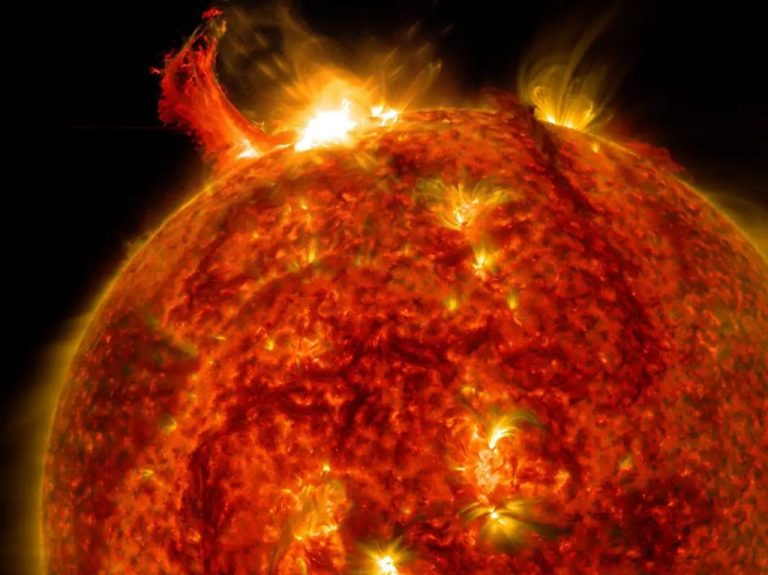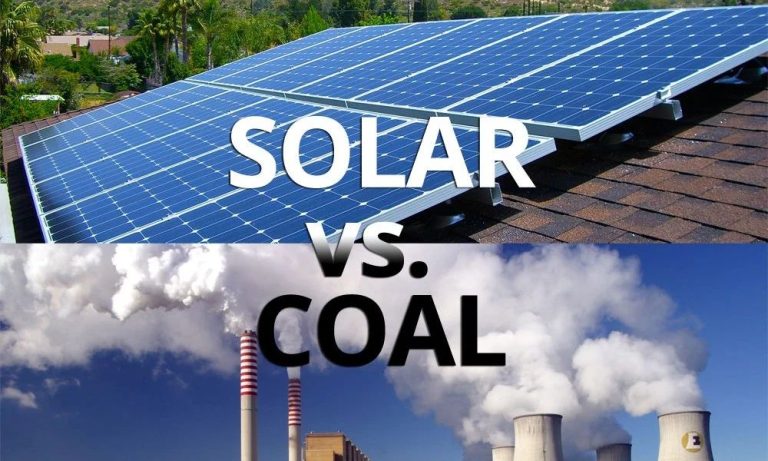Is Solar Radiation Heat Or Light?
Solar radiation refers to the radiant energy emitted from the sun. This energy reaches earth in the form of electromagnetic waves and includes infrared, visible light, and ultraviolet radiation. There is some debate over whether solar radiation should be considered heat or light given its complex nature. While visible light is what our eyes perceive from the sun, infrared radiation and ultraviolet radiation have properties of both heat and light. This article will explore the characteristics of the different types of solar radiation and examine the key reasons why solar radiation exhibits properties of both heat and light.
What is Solar Radiation?
Solar radiation is the radiant energy emitted from the sun that travels across space and reaches the Earth’s atmosphere. Solar radiation consists of electromagnetic waves with varying wavelengths and frequencies, ranging from infrared to visible light to ultraviolet radiation (Solar Radiation | Measurement, Types, Impact, Importance, …).
There are three main types of solar radiation:
- Infrared radiation – Provides heat and has longer wavelengths than visible light.
- Visible light radiation – Emits light that human eyes can detect.
- Ultraviolet radiation – Has shorter wavelengths than visible light.
All solar radiation originates from nuclear fusion reactions in the core of the sun. The sun produces solar energy through a process called nuclear fusion, in which hydrogen atoms fuse together under immense pressure and temperature to form helium. This fusion process releases photons in the form of solar radiation that radiate outward from the core of the sun (Types of Solar Radiation: Definition and Properties).
Infrared Radiation
Infrared radiation, sometimes called infrared light, is a type of electromagnetic radiation with wavelengths longer than that of visible light. The wavelength range for infrared radiation ranges from 700 nm to 1 mm. Infrared radiation is not visible to the human eye. However, we experience infrared radiation every day as heat. Any object that has a temperature above absolute zero emits infrared radiation.
Infrared radiation transfers energy in the form of heat. When infrared radiation strikes an object, it causes molecules in that object to vibrate. This vibration creates heat energy, warming the object. For example, we feel infrared radiation as heat from sunlight, fire, and warm objects such as people, animals, and engines. Greenhouse gases like carbon dioxide and methane absorb infrared radiation emitted by the Earth’s surface, causing the greenhouse effect that warms the overall climate (Source).
Infrared radiation is part of the electromagnetic spectrum with longer wavelengths than visible light. However, infrared radiation behaves similarly to visible light, it can be reflected, absorbed, and transmitted through different materials. Many materials that are opaque to visible light are transparent to some regions of infrared radiation.
Visible Light Radiation
Visible light is the part of the electromagnetic spectrum that is visible to the human eye. Visible light has wavelengths from about 380 to about 740 nanometers (1 nm = 10-9 m) [1]. This range corresponds to a frequency range of about 405 to 790 terahertz. Visible light allows us to see color and brightness.
The human eye senses visible light through cone cells and rod cells in the retina. The cone cells are sensitive to three different wavelength ranges that correspond to the colors red, green, and blue. The rod cells detect brightness but do not differentiate colors [2]. By combining input from the cone and rod cells, the eye can perceive the full visible spectrum of colors.
Examples of visible light include sunlight, light from light bulbs, candles, and fire. Fluorescent lights, LED lights, and neon lights also produce visible light. The rainbow is an example of visible light separating into its spectral components. Laser light and colors on an LCD screen are produced using visible light.
Ultraviolet Radiation
Ultraviolet (UV) radiation is a type of electromagnetic radiation that has shorter wavelengths and higher frequencies than visible light. According to the ThoughtCo definition, UV radiation ranges from wavelengths of 100-400 nm. UV radiation is further divided into three bands – UVA, UVB, and UVC.
UV radiation has several effects. It can cause sunburn and skin cancer in humans. It also contributes to aging of the skin. Exposure to UVB radiation suppresses the immune system and causes eye damage such as cataracts. In addition, UV radiation affects plant growth and aquatic ecosystems. On the positive side, it triggers the production of vitamin D in the body and is used to disinfect water and sterilize surfaces.
An important property of UV radiation is that it is ionizing radiation. This means it has enough energy to strip electrons from atoms and molecules, thereby producing ions. Ionizing radiation can break chemical bonds and cause damage to living tissue. In contrast, visible light and other lower frequency electromagnetic waves are non-ionizing forms of radiation.
Is Solar Radiation Heat or Light?
Solar radiation contains both heat and light energy. The sun emits electromagnetic radiation across a broad spectrum of wavelengths, including infrared, visible light, and ultraviolet (Source). The infrared portion of the solar spectrum contains heat energy that we perceive as warmth. When sunlight hits the Earth’s surface, the infrared radiation is absorbed and converted into heat (Source). On the other hand, the visible and ultraviolet light allow life on Earth through photosynthesis. So in summary, the heat we feel from sunlight is primarily infrared radiation, while the light enables plant growth through photosynthesis.
Importance of Solar Radiation
Solar radiation is vital for life on Earth. Without it, the climate would be too cold and most life as we know it would not exist. There are three key reasons solar radiation is so important:
Life on Earth is dependent on solar radiation. Plants, algae, and some bacteria use sunlight to produce energy through photosynthesis. This energy powers the entire ecosystem, allowing plants and animals to survive. According to research from Carbon Collective, solar radiation provides the energy that supports food chains and the cycling of nutrients in ecosystems (https://www.carboncollective.co/sustainable-investing/solar-radiation).
Solar radiation impacts Earth’s climate. Energy from the Sun heats up the atmosphere and surface of the planet. Without this heating effect, Earth’s average temperature would be below freezing. Solar radiation provides the energy that drives convection currents in the atmosphere and oceans, influencing weather and climate patterns.
Solar energy from radiation can be harnessed and used by humans. Solar panels convert sunlight into electricity without emitting greenhouse gases. Solar heating systems use solar energy to provide hot water. Solar cookers can cook food and sterilize water using only sunlight. Solar radiation provides a renewable energy source that reduces reliance on fossil fuels.
Measuring Solar Radiation
Several instruments are used to measure solar radiation, known as solar irradiance. A pyranometer is commonly used to measure global solar irradiance on a planar surface in watts per square meter (W/m2). It measures the solar radiation flux from the entire hemispheric sky diffused and direct radiation. Pyranometers use a thermopile sensor to generate a voltage proportional to the solar irradiance. Another common instrument is a pyrheliometer, which specifically measures direct beam solar irradiance from the sun. It tracks the sun to remain perpendicular to the direct solar beam.
Solar irradiance outside the Earth’s atmosphere is about 1,370 W/m2 and is known as the solar constant. However, solar irradiance at the Earth’s surface is lower due to scattering and absorption by the atmosphere. The average global solar irradiance at sea level is about 1,000 W/m2 on a clear day. Solar irradiance can vary depending on location, time of day, season, cloud cover, and other atmospheric conditions. Over longer time scales, changes in solar irradiance correlate with sunspot cycles and other solar variations.
Source: https://www.pveducation.org/pvcdrom/properties-of-sunlight/measurement-of-solar-radiation
Effects of Solar Radiation
Solar radiation has important effects on life on Earth. Visible light from the sun enables photosynthesis in plants and other organisms, providing the energy needed to sustain nearly all life on Earth (Saucedo, 2020). Ultraviolet radiation also has some benefits, as it triggers vitamin D production in human skin (Saucedo, 2020). However, overexposure to solar radiation can pose significant risks.
Excess ultraviolet radiation is a major cause of skin cancer in humans, with over 5 million cases diagnosed per year globally (Saucedo, 2020). Ultraviolet radiation causes DNA damage that can lead to skin cancer. Exposure to ultraviolet radiation also causes other issues like sunburn, premature skin aging, eye damage, and immune suppression (Saucedo, 2020). People who work outdoors are especially at risk for overexposure to solar radiation and adverse health effects like skin cancer and cataracts (Modenese, 2018).
While solar radiation is essential to life, it is important to limit overexposure to ultraviolet radiation, use sun protection methods, and take precautions to reduce the risks of skin cancer and other potential damage from excessive exposure.
Conclusion
In summary, solar radiation contains both heat and light. Solar radiation consists of infrared radiation, visible light, and ultraviolet radiation. While infrared radiation and ultraviolet radiation are forms of heat energy, visible light is a type of electromagnetic radiation that allows us to see. Understanding the components of solar radiation is important because it impacts life on Earth in many ways.
Solar radiation provides the energy that drives weather patterns and ocean currents. It also enables photosynthesis in plants, which generates oxygen and provides food. At the same time, excessive exposure to solar radiation can damage skin and eyes. Measuring and studying solar radiation helps us track climate change trends and protect ourselves from harm. With a complete picture of what comprises solar radiation, we can better harness its benefits while mitigating its risks. The sunlight that reaches Earth is critical for sustaining life, and comprehending its full nature allows us to exist safely within our solar system.







